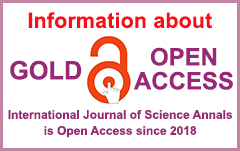| 1 Dental Clinic “Zahnzentrum Rudow“, Germany 2 Medical University – Sofia, Bulgaria |
Abstract
Background and Aim of Study: The significance of the risk factors, including behavioral and social characteristics of the patients, for the occurrence of stomach cancer is constantly increasing and largely determines the development and outcome of the disease.
The aim of the study: to provide empirical data for the significance of behavioral and social factors on gastric cancer incidence and mortality.
Material and Methods: Data from a study of gastric cancer patients (234 men and 144 women) examined at the Heidelberg University Clinic (Germany) were used. Risk factors, gastric cancer survival and mortality, factors of fatal outcome of gastric cancer patients were compared. Multiple binary logistic regression analysis was used to quantitatively assess their influence. To analyze the possible statistical significance between different groups, we used Fisher’s exact test and chi-squared test for the relationship between categorical variables and Student’s t-test. The significance level (rejecting the null hypothesis) is p<0.05.
Results: The most common risk factors are lack of physical activity, smoking, accompanying cardiovascular diseases, as well as emotional stress. Unhealthy lifestyle increases the risk by 56.8%. With a lower but significant percentage are overweight and alcohol abuse. We found the presence of emotional stress in 25.3% of patients with stomach cancer. Jobs with primary mental work and high stress level increase the probability of negative outcome. Mainly mental work is associated with about 8 times the risk of death compared to physical work. The presence of stress increases the lethal risk about 3.2 times.
Conclusions: Risk factors related to healthy lifestyle of the patients, including mental health, play an important role in the development of stomach cancer. They largely determine the status, disease control, treatment, survival and mortality of gastric cancer patients.
Keywords
risk factors, survival and mortality, smoking, stress, physical inactivity, overweight, alcohol abuse
References
Arnold, M., Moore, S. P., Hassler, S., Ellison-Loschmann, L., Forman, D., & Bray, F. (2014). The burden of stomach cancer in indigenous populations: A systematic review and global assessment. Gut, 63(1), 64-71. https://doi.org/10.1136/gutjnl-2013-305033
Asplund, J., Gottlieb-Vedi, E., Leijonmarck, W., Mattsson, F., & Lagergren, J. (2021). Prognosis after surgery for gastric adenocarcinoma in the Swedish Gastric Cancer Surgery Study (SWEGASS). Acta Oncologica, 60(4), 513-520. https://doi.org/10.1080/0284186X.2021.1874619
Camargo, M. C., Anderson, W. F., King, J. B., Correa, P., Thomas, C. C., Rosenberg, P. S., Eheman, Ch. R., & Rabkin, C. S. (2011). Divergent trends for gastric cancer incidence by anatomical subsite in US adults. Gut, 60(12), 1644-1649. https://doi.org/10.1136/gut.2010.236737
Compare, D., Rocco, A., & Nardone, G. (2010). Risk factors in gastric cancer. European Review for Medical and Pharmacological Sciences, 14(4), 302-308. https://pubmed.ncbi.nlm.nih.gov/20496539/
Correa, P., Haenszel, W., Cuello, C., Tannenbaum, S., & Archer, M. (1975). A model for gastric cancer epidemiology. The Lancet, 306(7924), 58-60. https://doi.org/10.1016/S0140-6736(75)90498-5
Den Hoed, C. M., & Kuipers, E. J. (2016). Gastric cancer: How can we reduce the incidence of this disease? Current Gastroenterology Reports, 18(7), 34. https://doi.org/10.1007/s11894-016-0506-0
Dong, J., & Thrift, A. P. (2017). Alcohol, smoking and risk of oesophago-gastric cancer. Best Practice & Research. Clinical Gastroenterology, 31(5), 509–517. https://doi.org/10.1016/j.bpg.2017.09.002
Hoff, P. M., Pazdur, R., Benner, S. E., & Canetta, R. (1998). UFT and leucovorin: A review of its clinical development and therapeutic potential in the oral treatment of cancer. Anti-Cancer Drugs, 9(6), 479-490. https://pubmed.ncbi.nlm.nih.gov/9877235/
Kim, E. Y., Jun, K. H., Kim, S. Y., & Chin, H. M. (2020). Body mass index and skeletal muscle index are useful prognostic factors for overall survival after gastrectomy for gastric cancer: Retrospective cohort study. Medicine, 99(47), e23363. https://doi.org/10.1097/MD.0000000000023363
Kogevinas, M., & Porta, M. (1997). Socioeconomic differences in cancer survival: A review of the evidence. IARC Scientific Publications, 138, 177-206. https://pubmed.ncbi.nlm.nih.gov/9353665/
Kuwahara, A., Takachi, R., Tsubono, Y., Sasazuki, S., Inoue, M., & Tsugane, S. (2010). Socioeconomic status and gastric cancer survival in Japan. Gastric Cancer, 13, 222-230. https://doi.org/10.1007/s10120-010-0561-4
Nikolov, A., & Georgieva, L. (2022). Significance of palliative care for the quality of life for oncology patients. International Journal of Science Annals, 5(1-2), 39-43. https://doi.org/10.26697/ijsa.2022.1-2.4
Popp, S., Mang, T., & Scharitzer, M. (2022). Einfluss des Rauchens auf den Gastrointestinaltrakt [Influence of smoking on the gastrointestinal tract]. Die Radiologie, 62(9), 772-780. https://doi.org/10.1007/s00117-022-01017-3
Sarkar, S., Dauer, M. J., & In, H. (2022). Socioeconomic disparities in gastric cancer and identification of a single SES variable for predicting risk. Journal of Gastrointestinal Cancer, 53, 170-178. https://doi.org/10.1007/s12029-020-00564-z
Siegrist, K., & Siegrist, J. (1987). Psychosocial factors in the course of gastric cancer. Scandinavian Journal of Gastroenterology, 22(Sup133), 90-92. https://doi.org/10.3109/00365528709091027
Sklar, L. S., & Anisman, H. (1981). Stress and cancer. Psychological Bulletin, 89(3), 369-406. https://doi.org/10.1037/0033-2909.89.3.369
Song, H., Held, M., Sandin, S., Rautelin, H., Eliasson, M., Söderberg, S., Hallmans, G., Engstrand, L., Nyrén, O., & Ye, W. (2015). Increase in the prevalence of atrophic gastritis in adults aged 35 to 44 years in Northern Sweden between 1990 and 2009. Clinical Gastroenterology and Hepatology, 13(9), 1592-1600. https://doi.org/10.1016/j.cgh.2015.04.001
Tabuchi, T. (2020). Cancer and socioeconomic status. In K. Kondo (Ed.), Social Determinants of Health in Non-communicable Diseases. Springer Series on Epidemiology and Public Health (pp. 31-40). Springer. https://doi.org/10.1007/978-981-15-1831-7_4
Tonelli, F., Valanzano, R., Monaci, I., Mazzoni, P., Anastasi, A., & Ficari, F. (1997). Restorative proctocolectomy or rectum-preserving surgery in patients with familial adenomatous polyposis: Results of a prospective study. World Journal of Surgery, 21, 653-659. https://doi.org/10.1007/s002689900289
Uthman, O. A., Jadidi, E., & Moradi, T. (2013). Socioeconomic position and incidence of gastric cancer: a systematic review and meta-analysis. Journal of Epidemiology & Community Health, 67(10), 854-860. https://doi.org/10.1136/jech-2012-201108
Yusefi, A. R., Bagheri Lankarani, K., Bastani, P., Radinmanesh, M., & Kavosi, Z. (2018). Risk factors for gastric cancer: A systematic review. Asian Pacific Journal of Cancer Prevention: APJCP, 19(3), 591–603. https://doi.org/10.22034/APJCP.2018.19.3.591
Nikolov Alexander (Corresponding Author) – https://orcid.org/0000-0001-5414-9378;
Georgieva Lidia – https://orcid.org/0000-0002-9320-9203; Doctor of Medical Sciences, MD, Professor, Medical University – Sofia, Sofia, Bulgaria.
| |
APA
Nikolov, A., & Georgieva, L. (2023). Influence of behavioral and social factors on gastric cancer incidence and mortality. International Journal of Science Annals, 6(1), 40–45. https://doi.org/10.26697/ijsa.2023.1.4
Harvard
Nikolov, A., & Georgieva, L., 2023. "Influence of Behavioral and Social Factors on Gastric Cancer Incidence and Mortality". International Journal of Science Annals, [online] 6(1), pp. 40–45. viewed 30 June 2023, https://culturehealth.org/ijsa_archive/ijsa.2023.1.4.pdfVancouver
Nikolov A., & Georgieva L. Influence of Behavioral and Social Factors on Gastric Cancer Incidence and Mortality. International Journal of Science Annals [Internet]. 2023 [cited 30 June 2023]; 6(1): 40–45. Available from: https://culturehealth.org/ijsa_archive/ijsa.2023.1.4.pdf https://doi.org/10.26697/ijsa.2023.1.4











